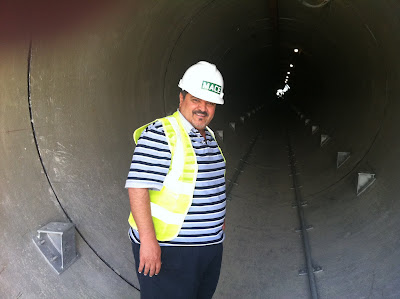


Sociology’s big question focuses on how existing larger social forces around us impact human activity and shape virtually every aspect of our lives. They affect the simplest mundane behavior and actions such as the way we address our mentors, the way we walk, talk, move, act and interact in public and with the public. In other words, sociology allows us to see and understand the world and the way it works in a whole new perspective. As sociologist Peter L. Berger explains: “the first wisdom of sociology is this – things are not what they seem.”

From using credit cards to the way we dress, to construction here in Doha, the influences of social factors become easier to interpret, detect, and understand, when we adopt a quality of mind that allows us to do so, called the social imagination.


First, when visiting a construction site, the most obvious social force to consider is the everlasting effect of the Industrial Revolution which according to the book by Joan Ferrante, is partly the reason for the emergence of sociology. Apart from the changes in transportation, tunneling and manufacturing which are all applicable to the construction industry in Qatar, Berger highlights the process of mechanization as the central feature of the Industrial Revolution. The process of mechanization is significant in infrastructure work sites. Skilled workers have shifted into the roles of machine operators and automated labor force, where the pile-driving machines do the excavations, and the cranes do the heavy lifting and moving of heavy materials such as pipelines.


The workers perform non-skill demanding tasks such as fixing pipe supports in place in the concrete tunnel, preparing to place the pipes on the side anchors inside the tunnel and placing the belt around the pipes for crane lifting.


Use of railroads is also applicable in infrastructure. The video below shows a battery-operated engine as it drives the tires that move the pipes along a railway into the tunnel. In addition to the rails on the bottom that are built for the pipes, there are rails on the top to transport workers into the tunnel as well.



At times where leveling and balancing the pipes in place required skill and timing-perfection of the laborers, the total station surveying instrument is a technology that enables the surveyor to accurately place the pipes to accurate level and alignment.


However, a process such as GRP pipe lamination still requires skill combined with the use of technology and machinery. Apart from technology, globalization is another force that influenced infrastructure in Doha by allowing western innovations such as GRP pipe lamination and other tactics and procedures to be integrated here in this region. By doing so, older methods are eradicated and newer ones are introduced. Adopted methods from other places around the world can also altered and improved to create more appropriate solutions.

Symbolic meaning is another social force that can be noted while observing a construction site. Symbols such as the workmen’s protection equipment, helmets, gloves, and protective clothing and the company’s logo have a shared assigned meaning or value. A particular dress code could signify a person’s station or job rank. The company’s name or logo on the workers’ vests can mean the company itself, the field of construction, site work, infrastructure or a even a shared feeling of affinity and belonging to a certain group, where all members of the company or workers feel a sense of solidarity.


The social status or ranks in a construction organization is the social force that determines how different employees interact with each other. The general hierarchy of positions in a construction company usually includes: the managing director, site engineers, superintendants, general foremen, foremen, crew leaders and workers. The social status of say, a foreman, and the associated roles and attributes of this role influences the way in which the workers respond to the foreman’s orders by obeying him, as well as the way they address him and speak to him. The foreman for example is most likely to be assertive and authoritative and the workers are likely to comply. Each status affects the way these people interact with each other. This sharing of meaning and interpretation of symbols relates to the sociological theory called the Symbolic Interactionist Theory, which in this case would be used to examine the role of symbols in shaping social interaction among individuals including their daily communication and response to each other.


Ultimately, industrialization changed more than just the way things operate. It changed how people lived their own lives and the lives of everyone around them. According to Ferrante, developments such as the railroads, electricity, and the steamship changed our perception of time and space. The time needed to complete a project such as the ones shown in the pictures, or for building a skyscraper, and the way engineers and project managers negotiate this time has changed dramatically and will continue to change. In turn these changes affect the entire execution of a project and its completion date. Moreover, the changes in the process of shipping of equipment and materials, introduction of new machinery and technology and moving them across sites contribute to the emergence of a fast-paced, mechanized, bottom-line thinking, consumption-oriented economy and wealth-pursuing culture.

No comments:
Post a Comment
Note: Only a member of this blog may post a comment.